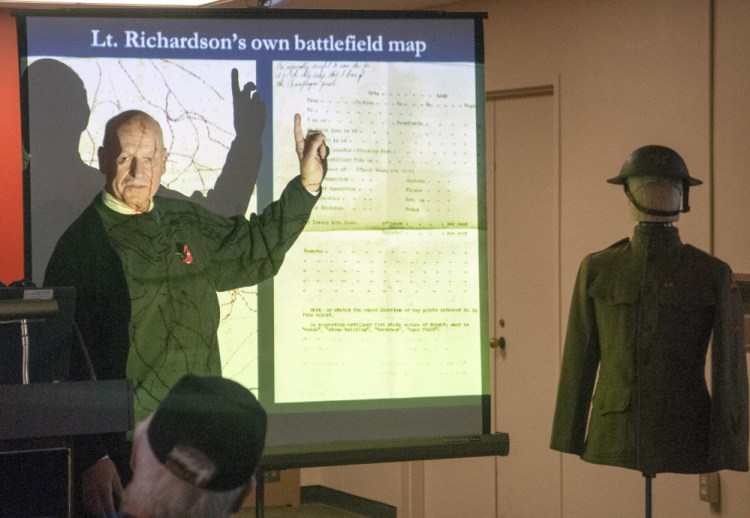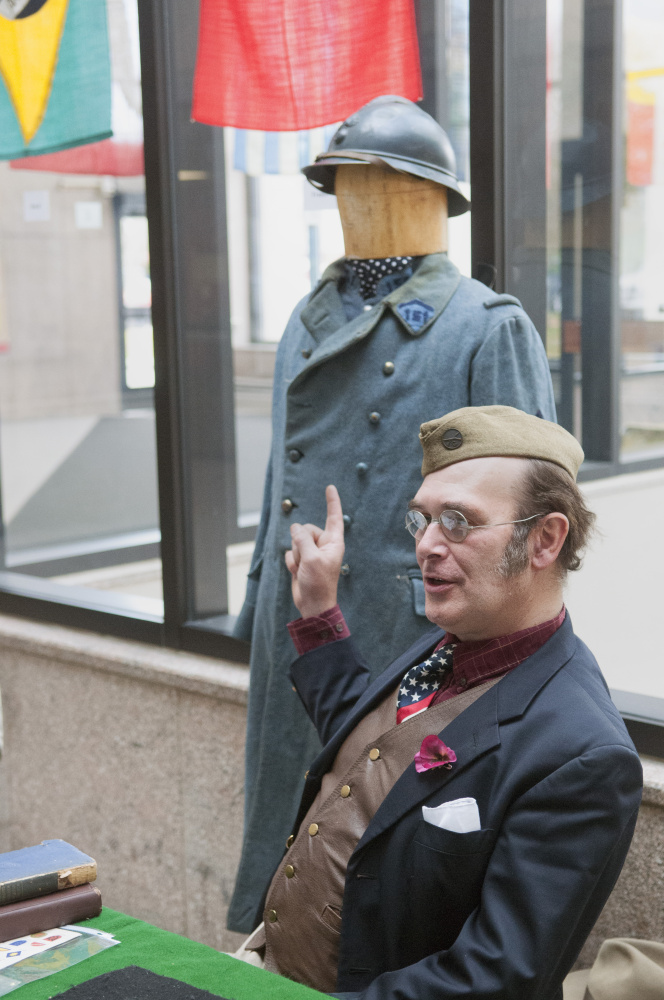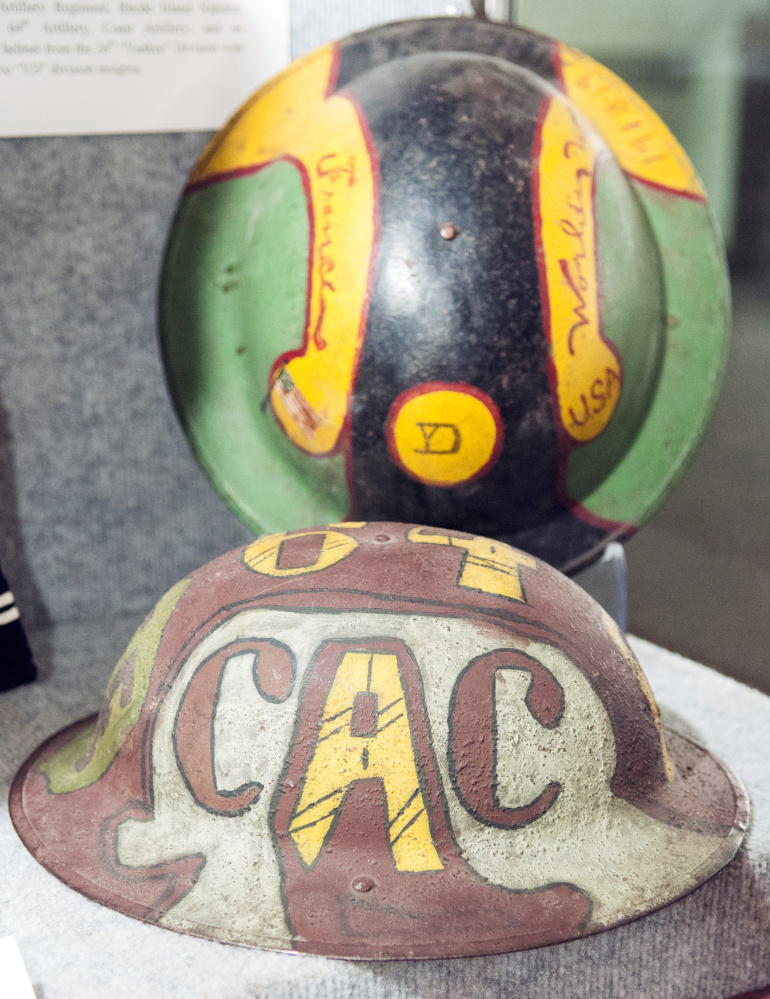AUGUSTA — With the 100th anniversary of the United States’ entry into World War I to be commemorated next April, the Maine State Museum invited people to bring in their own artifacts from those war years.
They were displayed Saturday as part of a Pop-Up Museum set in the entryway to the Cultural Building and in the anteroom of the Maine State Museum, the Maine State Archives and the Maine State Library.
“We are working on a World War I exhibit that will open next year,” said Joanna Torow, chief educator at the Maine State Museum. She said the exhibit will focus on the experience of Mainers both at the homefront and in the war itself, and the museum staff and others wanted to see what those in the community have.
At one of the tables, Richard Colton, who recently retired as a historian for the National Park Service at the Springfield (Massachusetts) Armory, said someone brought in a poster from that period.
He was preparing to offer a lecture on “The Things He Carried and Kept: An American Infantryman’s Experience Fighting in France, October 1918.”
Colton said servicemen brought home chests with military memorabilia. He described one chest in particular, he said, which was brought into his local historical society in 1998 and which had been locked, with the key broken off, since 1962.
“There was everything from photos, uniform pieces, uniforms, Army documents, his letters, his medals and boxes of tickets from where he’d been.” Colton said, adding, “The letters were quite complete.”
Christopher Montagna, of Manchester, brought in a soldier’s field gear, including a backpack, a canteen, a mess kit, an ammunition belt and a trench lighter. He also had a small bound copy of “The President’s War Message,” a copy of the declaration of war.
“It let people know why they’re fighting,” he said.
Montagna said he started as a collector but is now more a preservationist. He finds items at antique stores and flea markets.
He had the medals of Joseph LeMay, of Lewiston, who served with the 103rd division of the Maine National Guard. The medals, offered to him by one of LeMay’s descendants, were placed next to a Purple Heart of John Laughlin, of Bangor, which Montagna found at an antique store.
Montagna also had a sailor’s uniform shirt belonging to Sidney S. Anthony, who served from April 14, 1917, to April 13, 1921, and who died in Augusta in 1989 in Augusta at age 89.
Montagna found it at a thrift shop being sold as a Halloween costume. He was able to identify its owner because Anthony’s name was embossed near the hem on the back of the shirt.
Montagna’s son Alex, 14, was with him Saturday at the museum, but Alex said he was more interested in the Civil War period.
Lillian Sears and Duane Burbank, of Jay, represented the Jay Historical Society and brought issues of the Jay High School publication Clavis, in which the principal urges sacrifice for the war effort.
Lt. Jonathan Bratten, of the Maine Military Historical Society, said the museum near Camp Keyes has a number of items from World War I and that they are being sorted to see which ones should be displayed there and which can be lent to other museums.
“This was the first time they mobilized every National Guard unit for the wartime effort,” he said. The mobilization came about a week after war was declared.
Bratten is also command historian for the Maine Army National Guard,
Maine State Historian Earle Shettleworth Jr. gave a talk on Mainers’ involvement in the war effort, offering a slideshow that included a photo of a 19- or 20-year-old Margaret Chase Smith in a white Red Cross uniform in front of the Red Cross Office in Skowhegan.
He had pictures of ships being launched from South Portland, a submarine launching in April 1917 at the Portsmouth Naval Shipyard in Kittery, and artillery shells being assembled by women in a Portland foundry.
Shettleworth said The Emergency Fleet Corp. erected two entire neighborhoods of houses in Bath designed for workers at Bath Iron Works and their families, he said.
Parades across the state encouraged patriotism, conservation and the need to sacrifice for the national war effort.
A poster printed when Carl E. Milliken was governor of Maine urged people to “Eat More Potatoes and Save the Wheat” for the troops.
Shettleworth said the war effort “cut across all social boundaries,” and one black-and-white photograph showed the summer residents of Seal Harbor sitting side by side with local women as all rolled bandages for French hospitals.
He said Cyrus Curtis, the publisher of the Saturday Evening Post and the Ladies’ Home Journal, who summered in Rockport, donated his personal yacht, Lyndonia, to the government in 1917 for the war effort.
The Maine State Library brought out selections from its World War I holdings.
Heather Lyon, an intern at the library, paged through a scrapbook of the war years complied about 1922 by Isadora Linscott, of Farmington, as well as a compilation of color sketches of various officers drawn by Lucien Jonas (1880-1947).
“This is the first time, as a pilot, we’ve done this,” said Alison Maxell, the library’s director of public and outreach services. “We’re really excited.”
The collaborative effort included a display by the archives of a copy of Albert A. Peavey’s honorable discharge — including the campaigns he participated in: Xivray, the 2nd Battle of Marne, St. Mihiel-Salient and the Argonne — and his ammunition box was displayed in a glass case across the room.
Betty Adams — 621-5631
Twitter: @betadams
Send questions/comments to the editors.






Success. Please wait for the page to reload. If the page does not reload within 5 seconds, please refresh the page.
Enter your email and password to access comments.
Hi, to comment on stories you must . This profile is in addition to your subscription and website login.
Already have a commenting profile? .
Invalid username/password.
Please check your email to confirm and complete your registration.
Only subscribers are eligible to post comments. Please subscribe or login first for digital access. Here’s why.
Use the form below to reset your password. When you've submitted your account email, we will send an email with a reset code.